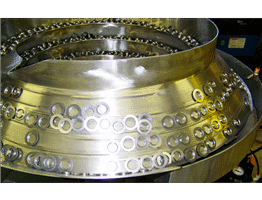 Hoosier Feeder Company understands what makes an excellent feeding system and has the experience to guide you through your purchase. We offer our insight to ask the right questions and give you accurate answers so that you can feel confident in the feeding system we deliver to you.
Hoosier Feeder Company understands what makes an excellent feeding system and has the experience to guide you through your purchase. We offer our insight to ask the right questions and give you accurate answers so that you can feel confident in the feeding system we deliver to you.
Does the system damage the parts being fed in any way?
- Scuffed, broken and/or bent parts are considered waste. Your parts feeding system should manipulate parts gently, or in a way that does not hinder the function, fit, or finish of the part.
Does your system supply parts a rate necessary to maintain production?
- If a feeder cannot feed parts at a rate consistent with or greater than the rest of the line, it is the weakest link and holding production capabilities back.
Are 100% of the parts presented in the correct orientation?
- Incorrectly oriented parts entering the next phase of production may cause damage to other parts or neighboring machinery and could halt production until the broken pieces are collected. You need a feeder to reliably deliver “good” parts so you can plan for maximum production.
Were the proper materials used in the construction of the system to offer maximum life expectancy?
- Individual parts vary as widely as the product they make up; which means the feeder must be equipped with appropriate materials to handle them. A feeder system optimized to feed heavy, hard parts should be built with stronger and more robust materials than a feeder built for, for example, small rubber parts.
Does the system produce too much noise pollution for the application at hand?
- Depending on your specific scenario, you may want to maintain a maximum noise level to protect nearby workers. There are several methods for reducing the noise of a feeding system and it is important to use as many or as few as it takes balancing cost and noise dampening effectiveness.
How long does the system feed parts without needing refilled?
- When a parts feeding system runs out of parts, it can result in both minor and major problems, but ultimately means a slower production pace. Both bowl and hopper capacities need to be selected to ensure you can plan on sufficient operating time before the system has to be refilled.
Does the feeder system require user interference on a regular basis to remain jam-free?
- A reliable feeder should consistently and constantly feed parts. There should be an effort to supply the system with appropriately clean and consistent parts but if a worker has to remove a part jam on a regular basis, the feeding system is not operating as it should.
When feeding multiple parts is the tooling change over convenient and easy to perform?
- When feeding multiple parts, changeover time is always a consideration. It is likely that a feeder system will require some kind of tooling change when changing parts but any necessary adjustment should be as simple and accessible as possible to reduce down time.
You have to look at systems overall maintenance free life cycle. ( How long can the machine run without having to be maintained)
- Feeding systems vary in life cycle depending on the part it is feeding and the environment in which it is operating. If a system operates under the manufacturer’s suggested settings and conditions, you should get years of use out of a feeder system with no maintenance to the major components.
Learn More
Are you still unsure which type of feeder your facility needs? Contact us today for a consultation.
August 29, 2017
Related Topics: Vibratory Feeders, Centrifugal Feeders